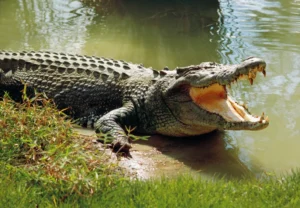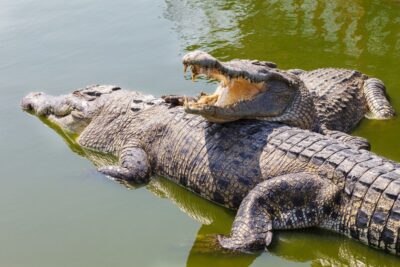Ever wondered how fast can a crocodile swim through the water? It’s like they’ve got this underwater turbo mode, right? Well, buckle up because we’re about to dive into the fascinating world of crocodile speed.
You’ve probably seen those slow-motion videos of crocodiles lurking near the surface, looking all calm and collected. But don’t let that fool you – when these reptiles decide to turn on the jets, they can clock some seriously impressive speeds.
So, how fast can a crocodile swim, you ask? Get ready for some jaw-dropping numbers as we unravel the mystery behind these aquatic speed demons. It’s time to see just how swift these scaly predators can be when they kick it into high gear.
How fast can a crocodile swim?

Crocodiles are known to be proficient swimmers and can move through the water quite swiftly. On average, a crocodile can swim at a speed of around 20 to 25 miles per hour (32 to 40 kilometers per hour) in short bursts.
However, they are more adapted to stealth and ambush tactics rather than long-distance, sustained swimming. Crocodiles are known to be excellent floaters and can cover large distances in water, especially during migration or in search of new territories.
Their streamlined bodies and powerful tails contribute to their efficient swimming abilities. It’s important to note that the specific speed can vary between different species of crocodiles.
Understanding crocodile swimming speed
Crocodile swimming speed is influenced by various factors, including the species, size, and age of the crocodile. Here are some key points to help you understand their swimming abilities:
- Species Differences:
- Different species of crocodiles have varying swimming capabilities. For example, the Nile crocodile (Crocodylus niloticus) is known for its speed in water, while others may not be as swift.
- Size and Age:
- Larger crocodiles tend to swim faster than smaller ones. Additionally, older and more experienced crocodiles may be more adept at swimming compared to younger individuals.
- Bursts of Speed:
- Crocodiles are not built for sustained, long-distance swimming. Instead, they excel in short bursts of speed, especially when they are ambushing prey or defending their territory.
- Technique:
- Crocodiles use their powerful tails for propulsion. Their bodies are streamlined, allowing them to move quickly through the water. They can also partially submerge themselves, with only their eyes and nostrils above the water, for stealthy movement.
- Hunting Strategy:
- Crocodiles often rely on stealth and surprise when hunting. They may float or swim slowly, blending into their surroundings, and then explode into action with a burst of speed when ambushing prey.
- Adaptations:
- The physical adaptations of crocodiles, such as their muscular tails, webbed feet, and streamlined bodies, contribute to their swimming prowess. These adaptations make them well-suited for both aquatic and terrestrial environments.
- Environmental Factors:
- The type of water, including its current and temperature, can influence a crocodile’s swimming speed. In some cases, they may be more agile in certain water conditions.
Importance of Crocodile Swimming Speed
The swimming speed of crocodiles is essential for various aspects of their behavior, survival, and ecological role within their habitats. Here are some important aspects highlighting the significance of crocodile swimming speed:
- Hunting and Feeding:
- Crocodiles are ambush predators that often rely on stealth and speed to capture their prey.
- A faster swimming speed allows crocodiles to surprise and overtake their prey more effectively, increasing their chances of a successful hunt.
- Swift movement in the water enables crocodiles to cover larger territories in search of food.
- Escape and Avoidance:
- Crocodiles may encounter threats from larger predators or even from other crocodiles.
- Fast swimming speed is crucial for escaping from danger and avoiding potential confrontations.
- Quick movements in the water contribute to their ability to evade predators or human disturbances.
- Territorial Defense:
- Crocodiles are territorial animals, and disputes over territory or mates can arise.
- A high swimming speed allows crocodiles to patrol and defend their territories effectively, helping to deter intruders.
- Migration and Dispersal:
- Some crocodile species are known to cover long distances in water.
- Efficient swimming is essential for migration between different habitats, especially for species that move between freshwater and saltwater environments.
- Environmental Adaptation:
- Crocodiles inhabit a variety of aquatic environments, from freshwater rivers and lakes to brackish and saltwater habitats.
- Their swimming abilities enable them to navigate and adapt to diverse ecological conditions, contributing to their ecological success.
- Thermoregulation:
- Crocodiles are ectothermic, meaning they rely on external sources to regulate their body temperature.
- Swimming allows them to move between warmer and cooler areas, helping regulate their body temperature according to environmental conditions.
- Reproduction:
- During the breeding season, crocodiles may engage in courtship displays and territorial behaviors.
- Swimming speed is essential for navigating waterways and reaching suitable nesting sites.
- Survival Strategies:
- Fast swimming can be a survival strategy for crocodiles to avoid potential threats, including floods, droughts, and changes in environmental conditions.
- It contributes to their overall adaptability and resilience in dynamic ecosystems.
Understanding the importance of crocodile swimming speed provides insights into their ecological roles, evolutionary adaptations, and the ways in which they interact with their environments and other organisms. Crocodiles’ ability to move efficiently in water is a key factor in their success as ancient and highly specialized reptiles.
Factors influencing crocodile swimming speed

Crocodile swimming speed is influenced by various factors, including their anatomy, physiology, and environmental conditions. Here are some key factors that can affect crocodile swimming speed:
- Muscle structure and strength: Crocodiles have powerful muscles that enable them to generate significant propulsion in the water. The structure and strength of these muscles play a crucial role in determining their swimming speed.
- Tail morphology: The tail of a crocodile is a powerful swimming tool. The shape and musculature of the tail contribute to the efficiency of their swimming. A well-developed tail allows for strong propulsion and better control in the water.
- Body shape: Crocodiles have a streamlined body shape that reduces drag in the water. This streamlined design helps them move through the water with minimal resistance, allowing for faster swimming.
- Size and species: Larger crocodile species may have more muscle mass and longer bodies, potentially allowing for faster swimming speeds. Different species may also have variations in swimming capabilities based on their adaptations to different environments.
- Habitat and water conditions: The environment in which a crocodile swims can significantly impact its speed. Factors such as water temperature, salinity, and turbidity can affect a crocodile’s buoyancy and overall swimming performance.
- Temperature regulation: Crocodiles are ectothermic, meaning their body temperature is influenced by external conditions. Warmer temperatures can increase their metabolism and muscle function, potentially enhancing swimming speed.
- Behavior and motivation: Crocodiles may swim at different speeds based on their behavior and motivation. For example, if they are hunting, escaping a threat, or engaging in territorial disputes, they may swim more rapidly than when they are in a resting state.
- Age and health: The overall health and age of a crocodile can impact its swimming ability. Younger, healthier individuals may be more agile and capable of faster speeds than older or less healthy ones.
- Predator or prey interaction: If a crocodile is chasing prey or evading a predator, it may swim at different speeds depending on the urgency of the situation. This adaptive response can influence their swimming behavior.
Understanding these factors provides insights into the diverse ways in which crocodiles have adapted to their aquatic environments, showcasing their remarkable capabilities as skilled swimmers and predators.
Crocodile Species and Swimming Speed
Crocodile species vary in size, habitat, and behavior, and these factors can influence their swimming speeds. While specific data on the swimming speeds of different crocodile species may be limited, general observations and characteristics of certain species can be considered. Here are a few examples:
- Nile Crocodile (Crocodylus niloticus):
- Found in various freshwater habitats across Africa.
- Known for being an excellent swimmer.
- Capable of swift and rapid movements in water.
- Can reach relatively high speeds when chasing prey or escaping danger.
- Saltwater Crocodile (Crocodylus porosus):
- Largest living crocodile species.
- Inhabits brackish and saltwater environments in Southeast Asia, Northern Australia, and parts of the Indian subcontinent.
- Has been reported to swim at speeds of around 18-20 km/h (11-12 mph).
- Known for its ability to cover long distances at sea.
- American Crocodile (Crocodylus acutus):
- Found in coastal habitats of the Americas, including parts of the Caribbean, Central America, and South America.
- Generally considered a good swimmer but may not reach the same speeds as the saltwater crocodile.
- Prefers brackish and saltwater environments but can also inhabit freshwater areas.
- African Slender-Snouted Crocodile (Mecistops cataphractus):
- Found in freshwater habitats in West and Central Africa.
- Has a slender snout adapted for catching fish.
- While not as large as some other crocodile species, it is known for its agility in the water.
- Cuban Crocodile (Crocodylus rhombifer):
- Endemic to Cuba.
- Known for its relatively high level of aggression.
- Can move swiftly in the water, particularly when hunting.
Swimming speeds can vary within a species based on individual factors such as age, health, and size. Additionally, the swimming behavior of crocodiles is often context-dependent, influenced by factors such as hunting, territorial defense, and environmental conditions.
Measuring the exact swimming speed of crocodiles in the wild can be challenging, and much of the available information is derived from observations and limited studies. Researchers often rely on indirect methods, such as tracking devices, to estimate the movement patterns and speeds of these elusive reptiles.
Conclusion
The swimming speed of crocodiles is a crucial aspect of their survival and ecological function. These remarkable reptiles, equipped with streamlined bodies and powerful tails, exhibit varying speeds based on factors such as species, size, and environmental conditions.
How fast can a crocodile swim influences their effectiveness in hunting, evading threats, defending territories, and adapting to diverse aquatic environments. Their swift movements in the water not only contribute to successful predator-prey interactions but also play a vital role in their overall resilience and survival strategies within dynamic ecosystems.

